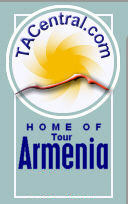 |
||||||||||||||||||||||||||||||
|
||||||||||||||||||||||||||||||
|
||||||||||||||||||||||||||||||
|
|||||||||||||||||||||||
|
|
|||||||||||||||||||||||
| Thursday, November 27, 2025 | |||||||||||||||||||||||
|
||||||||||||||||||||||||||||||||||||||||||||||||||||||||||||||||||||||||||||||||||||||||||||||||||||||||||||||||||||||||||
POPULATION AND PEOPLE Population flight began with the break up of the Soviet Union in 1991 and the collapse of the local economy. It has decreased the official figure by perhaps up to one million, many of whom left to seek employment elsewhere.
Population The census of 1989 recorded 3.6 million people in the republic, with 96% of the population ethnic Armenian, the other 4% divided between Russians, Jews, Greeks, Assyrians, Molokons, Yesdis, Udz and Gypsies. There are 27 cities, 31 towns, and 921 villages with the population density ranging from 17 to 330 per sq. kilometer. The largest city is Yerevan, recorded in 1989 with 1.4 million people. The next three largest cities are Giumri (pop 121,000), Vanadzor (pop. 74,000) and Abovian (pop. 54,000). 67.5% of population lives in urban areas, 32.5% in rural areas. Population flight began with the break up of the Soviet Union in 1991 and the collapse of the local economy. It has decreased the official figure by perhaps up to one million, many of whom left to seek employment elsewhere. The most intensive migration was to the central and southern regions of the Russian Federation, as well as to various CIS countries. At least 40, 000 people left for the United States and other industrialized countries. The vast majority live in Moscow, where the thriving economy generates enough income to send remittances to family members staying behind (as much as 250 million dollars a month). The Jewish and Greek populations were depleted with immigration by younger members to Israel and Greece. 2001 Census. Considered slanted in favor of overcounting by most international agencies, the 2001 census results from the government's Census and Demography Unit in November 2002 showed preliminary confirmation of 3,210,606 people "de jure" live in Armenia and 3,000,807 "de facto". ("de jure" means deducting those absent after 2 months, "de factor means deducting those absent after 6 months). By 2003, the completed census found an additional 200,000 people.Perhaps the most surprising results of the latest population study are that while in 1989 Females outnumbered Males 51.5% to 48.5%, it is now believed that for every male of marriageable age in the country there are 9.3 females. The greatest male-flight is in the age group eligible to serve in the army, and forced draft by the Military Ministry has prompted emigration out of Armenia by men from that age group. Moves by the government to cancel army exemption based on student status are expected to prompt further flight. Worldwide, the Armenian population is estimated at 8-9 million, with 2 million living in the USA, one million in Russia, and the rest divided between 60 countries, among the most populated by Armenians France, Argentina, Brazil, Australia, Georgia, Canada, Syria, Lebanon, and Iran. Estimated 60% of the total eight million Armenians lives outside Armenia in 60 countries, with one million in each the The probable actual population in 2004 is estimated by the UN at no more than 2.6 million, with 1.1 million living in Yerevan. People Armenia is the most homogenous of the former Soviet Republics, at least as far as other ethnic groups are concerned. As opposed to the Baltic States, where Russian immigration was an attempt at colonization of the countries, Russians did not achieve a significant margin of the Armenian population. At the same time, minorities in Armenia officially enjoy equal rights and full freedom. The government has adopted policies encouraging the minorities to develop their cultures and education, barring discrimination based on their religious beliefs, languages, traditions and customs. These freedoms are enshrined in the Declaration on Independence, which guarantees the "free and equal development of its citizens, regardless of national origin, race or creed." The table below shows detailed listing of populations, centers, language and religion. (supplied by the Armenian Ministry for Statitistics)
|
||||||||||||||||||||||||||||||||||||||||||||||||||||||||||||||||||||||||||||||||||||||||||||||||||||||||||||||||||||||||||
| |
Search | |
||||||



